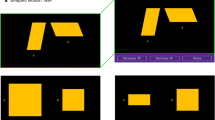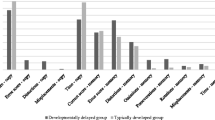Abstract
Objective : To construct a test used by community pediatricians and other professionals in the UK as a screening test for verbal and non-verbal development in children aged 2 to 4 years of age.Methods : A multifaceted developmental test of cognitive skills was constructed, modeled on theBus Puzde Test (Egan 1984) for its case of administration and appeal. Each stage in the design was piloted in Rajasthan in all socioeconomic groups. Stages include simple ethnic modification of the original test, development of more socioculturally appropriate scenes, a detailed statistical procedure of item analysis and reliability studies. The picture was converted into a wooden insert puzzle, calledThe Indan Picture Puzzle Test (IPPT) and standardized on a random sample of 616 children to construct the norms.Result : The IPPT assesses aspects of early language, picture interpretation, performance skills and conceptual development in children aged 2 to 5 years. Analysis of the standardized data highlighted the need for separate norms for each socioeconomic group.Conclusion : Verbal abilities were significantly different between advantaged and disadvantaged (slum and rural) groups though performance skills were comparable.
Similar content being viewed by others
References
Anandalakshmy S. There’s a method to measurement. In D Sinha, RC Tripathi, and G Misra, eds.Derivation — It’s Social Roots and Psychological Consequences. New Delhi: Concept Publishing Co. 1982; 37–47.
Aram D, Nation J. Preschool language disorders and subsequent language and academic difficulties.Journal of Communication Disorders 1980; 13:159–198.
Bernstein B. Class, codes and control, volume 3; Towards a Theory of Educational Transmissions. London: Routledge & Kegan Paul. 1975.
Bevli UK. Developmental Norms of Indian Children 2.6 to 5 years as obtained by the Cross Sectional and Longitudinal Studies, Report no. 3, National Council of Educational Research and Training, New Delhi. 1978.
Bevli UK.Researches in Child Development — A Book of Readings. New Delhi: National Council of Educational Research and Training. 1990; 1–6.
Carmines EG, Zeller RA.Reliability and Validity Assessment, London and New Delhi: Sage Publications Inc. 1979.
Clark EV. Meanings and Concepts. In JH Flavell and EM Markman, eds.Paul Mussen’s Handbook of Child Psychology,4th edn. Cognitive development. New York: Wiley. 1983; 3.
Davie R, Butler N, Goldstein H. From Birth to Seven: A Report of the National Child Development Study. London: Longman. 1972.
Davies, A.Principles of Language Testing. Cambridge, Mass.: Basil Blackwell Ltd. 1990.
De Zwart SH. Language acquisition and cognitive development. In T.E. Moore, ed.Cognitive Development and the Acquisition of Language. New York; Academic Press. 1973; 9–25.
Edwards JR.Language and Disadvantage. 2nd edn. London: Cole and Whurr Ltd. 1989.
Egan D, Brown R. Developmental assessment: 18 months to 4 1/2 years. The Bus Puzzle Test.Child : Care, Health and Development, 1984; 10 : 163–179.
Fenson L, Cameron MS, Kennedy M. Role of Perceptual and Conceptual Similarity in Category Matching at Age Two Years.Child Development 1988; 59: 897–907.
Harris J. Early Language Development. London: Routlegde. 1990.
Henning G.AGuide to Language Testing — Development, Evaluation, Research. Cambridge: Newbury House Publishers. 1987.
Jachuk K, Mohanty AK. Low SES and Progressive Retardation in Cognitive Skills: A Test of Cumulative Deficiency Hypothesis.Indian Journal of Mental Retardation 1974; 7: 36–45.
Mandler JM. Representation, In JH Flavell, Markman M, Paul H, eds.Mussen’s Handbook of Child Psychology-Cognitive Development 1983; 420–494.
McCauley R, Swisher L. Psychometric Review of Language and Articulation Tests for Preschool Children. Journal of Speech and Hearing Disorders, 1984; 49: 34–12.
Misra G, Shukla A. Recognition of Pictorial Material as a Function of Deprivation and Age.International Journal of Behavioural Development 1984; 95–103.
Misra G, Tiwari BK. Environment and Cognitive Development. In UK Bevli, ed.Researches in Child Development — A Book of Readings. New Delhi; National Council of Educational Research and Training. 1990.
Mittler P. Psychological Assessment of Language Abilities. In M. Rutter, ed.The Child with Delayed Speech. London: Spastics International Medical Publicaitons. Clinics in Developmental Medicine 1972; 43 : 106–119.
Mittler P, Serpell R. Services: An International Perpeptive. In AM Clarke, ADB Clarke, J. Berg, eds.Mental Deficiency the Changing Outlook. 4th edn. London : Methuen. 1985.
Murlidharan R. Early Child Development Instruments in India — A Review. In Landers Cassie, ed.Measuring the Development of Young Children: A Comparative Review of Screening and Assessment Techniques — Final Report. New York: UNICEF. 1992.
Pushpa M. Social Deprivation and Cognitive Styles. In UK Bevli, ed.Researches in Child Development — A Book Of Readings. New Delhi: National Council of Education Research and Training. 1990; 194–202.
Reichman J, Healey WC. Learning disabilities and conductive hearing loss involving otitis media.Journal of Learning Disabilities 1983; 16: 272–278.
Singhania RU. Design and Standardisation of a Developmental Test for Indian Children. A thesis submitted to the University of London for the degree of Doctor of philosophy in the Faculty of Medicine, Wolfson Center, Neurosciences Unit, Institute of Child Health, London. 1995.
Sinha D. Some Social Disadvantages and Development of Certain Perceptual Skills.Indian J Psych 1977; 52: 115–132.
Sommers RK Eridge S, Peterson MK. How valid are children’s language tests?The Journal of Special Education, vol. 12/no. 1978; 4: 393–407.
Srivasan R. A Comparative Study of Language Abilities and Scholastic Achievement of Secondary School Children belonging to Certain Social Categories. Ph.D. thesis, Delhi University. 1969.
Stein ZA, Susser MW. Mental retardation. In Last JM, Tyler CW, eds.Public Health and Preventive Medicine, 13th edn. Norwalk, CT: Appleton & Lange 1992; 963–972.
Tamjane SN. Basic Vocabulary of Marathi-Speaking Primary School Children. Nagpur University Training College, NCERT funded project. 1965.
The Market Research Society ManualHarmonisation of Demographics. The Market Research Society of India, Thomas Pulliyel, M.G. Road, Bombay. 1990.
Tripathi LB. Some Methodological Problems of Deprivation Studies. In D Sinha, RC Tripathi, G Misra, eds.Deprivation — Its Social Roots and Psychological Consequences. New Delhi, Concept Publishing Co. 1982; 49–67.
Whitehead M. Language and Literacy in the Early Years, Paul Chapman Publishing, London. 1990.
WHO. Protocol for the development and field testing of techniques for monitoring physical growth and psychosocial development. Division of Family Health and Division of Mental Health, Geneva: WHO/MCH/MNH 1986; 86 (1) : 9.
WHO. Assessment of people With Mental Retardation Division of Mental Health, Geneva: WHO/MNH/PSF/92.3. 1992.
Woodhead M. Intervening in Disadvantage. Windsor: NFER Publishing Co. Ltd. 1976.
Author information
Authors and Affiliations
Corresponding author
Rights and permissions
About this article
Cite this article
Singhania, R., Sonksen, P. The Indian Picture Puzzle Test — A developmental test designed and standardised for Indian children. Indian J Pediatr 71, 387–396 (2004). https://doi.org/10.1007/BF02725622
Issue Date:
DOI: https://doi.org/10.1007/BF02725622




